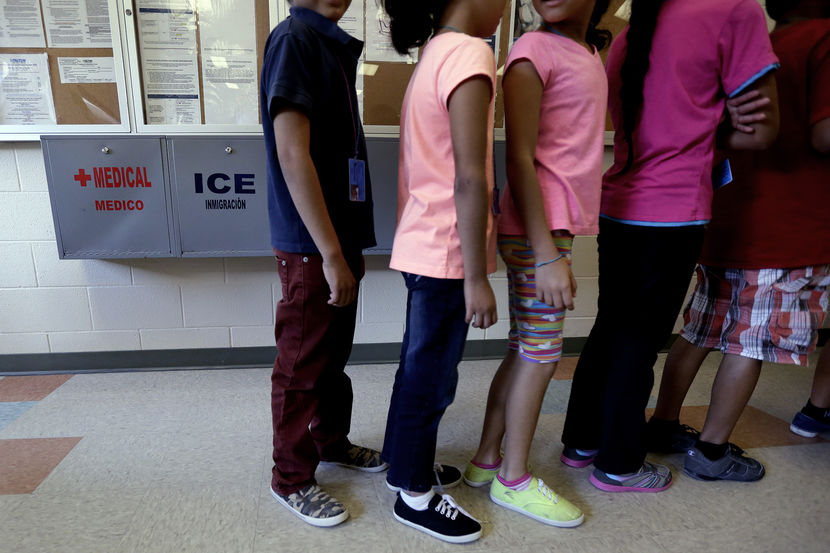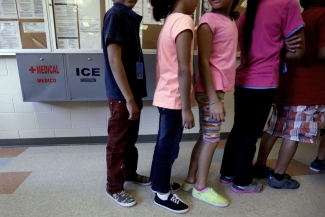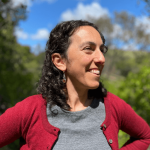ONE YEAR LATER Post-Migration Trauma and Evaluating Children in Texas Immigration Facilities: Q&A with Dr. Luis Zayas
[Editor’s note: This is the first in a series of blog posts exploring the health needs of the unaccompanied children and mothers with children who arrived at the US-Mexico border seeking asylum during last year’s ‘border surge.’ Subscribe to our blog to receive notifications of upcoming installments.]
Luis Zayas, PhD, is the Dean and Robert Lee Sutherland Chair in Mental Health and Social Policy, at the University of Texas at Austin’s School of Social Work. He is also a member of Migrant Clinicians Network’s External Advisory Board. For about a year, Luis has been regularly visiting the US Immigration and Customs Enforcement’s South Texas Residential Center in Dilley and Karnes County Residential Center, two Texas facilities housing many of the women and children who came to the US during the the US-Mexico “border surge” last year. (You can read more about MCN’s coverage and position on last year’s influx of immigrants seeking refuge in the US here.) The two facilities have been at the center of heated debate on the federal handling of the influx of immigrants; many human rights groups and others have called for their closure. As a national expert on the mental health of children and adolescents during deportation, Luis has been evaluating children primarily on behalf of the pro-bono attorneys at Karnes and Dilley who are presenting asylum claims on behalf of individual residents.
Lately, Luis has been even busier than usual: he’s been in the news, like the Huffington Post, the New York Times, the Associated Press, and elsewhere; he met with House Democrats when they recently toured the two facilities; and he continues to evaluate facility residents. We spoke with Luis the day after Homeland Security Secretary Jeh Johnson’s startling turnaround in policy regarding the length of detention for Karnes and Dilley residents. This was just a few days after the visit from the Congressional delegation was followed by a resident’s suicide attempt. In late June, he took some time out of his schedule to help us better understand the lives of the women and children, and what we as clinicians need to know.
 How did you first encounter migrant health issues, and how did you come to work with immigrant children in the Karnes and Dilley facilities?
How did you first encounter migrant health issues, and how did you come to work with immigrant children in the Karnes and Dilley facilities?
I came to the issue of immigration about ten years ago, pretty much as just a sedentary reader of the newspaper. But I became a very active participant when I got called in to evaluate a little girl whose father was challenging his order to be removed from the country. I evaluated her, we were able to get the cancellation of removal, and I realized that there was a whole lot there that was missing -- [like health] information about citizen children in these situations. The more I dug into the literature and science to see what we knew about these kids, we realized that we didn’t know much about what happened to them upon deportation. We have an idea of what living in the shadows of undocumented immigration does to kids, and to parents, and the fears and so on, but once their parents entered the detention system, there was really nothing. I decided to continue to work on cases like this, most of it in St. Louis. Then, I wrote a grant and studied what happens to these kids and was able to get that funded.
Then, last summer, with the surge at the border, I was asked to come in and evaluate children, but this was a unique thing. These weren’t US citizen children whose parents were being deported; these were immigrant kids, who came with loads of trauma from their countries of origin, whether it was domestic violence, community violence that they saw on the streets or were a victim of -- I’m talking about gangs, parents being extorted for money, and the complicity [or] inaction of the police…. This was a whole new thing [for me]: the pre-migration trauma. Then there’s the peri-migration trauma -- the process of crossing 1,800 miles from Honduras, a little less from the bordering countries…. and the kind of things these children saw, and witnessed, and were subjected to, and their mothers subjected to.
And then they arrive at our country [to seek asylum, hoping] that they will be greeted and brought into safety, and instead they’re put into hieleras -- the ice boxes -- and then put into detention, for 10 or 11 months now in some cases.
What work have you been doing in the facilities?
I’ve been evaluating children primarily on behalf of the pro-bono attorneys who are down at Karnes and Dilley who are doing the asylum claims… by showing the situations that the children are in. It’s an interesting thing, because I have to focus on what’s happening to them as a result of being in detention -- we have to set aside all the other trauma, because the issue is, how is detention harming these kids? I get a rough idea of what had happened back home, but the issue is, how has it been since you’ve arrived here? What are people doing to you? What are you doing? What are you thinking? Are you dreaming? Having nightmares? Eating, sleeping…?It’s a very narrow band of attention. But when a child is there three months, six months, nine months, there’s plenty for them to tell you.
What is the goal of your work at Dilley and Karnes?
At the case level, it’s really to help the families get bonds and get released to their families here in the US. Just about 99% of these families, these women and children, have family here in the US that they’re going to see. I’ve already interviewed kids on their way to Florida, Virginia, Michigan, California, and many are coming to places like Houston, within Texas…. At the overall level, it’s using all those cases, consolidate them and show the government the damage that’s being done to these children and their mothers, and therefore to end family detention.
Today, Homeland Security Secretary Jeh Johnson issued a statement saying he’s changing some of the approaches in these immigration centers, including shortening immigrants’ stays. What’s your reaction?
These children, in my mind and with my experience with them, should spend no more than 14 days in a detention facility. None of these mothers, by the way, say to me, ‘We expected to waltz into the country and continue on.’ They knew they were going to be detained, but they didn’t expect it to be this long. The children that I’ve seen -- they could understand two weeks of detention, where they are processed, where health examinations are done, maybe [given] immunizations and vaccinations…. That would not be harmful. They would understand it, especially if these detention centers are set up to be what they should be -- which is resettlement centers, a stopping-off point to get them to their destinations, rather than a place where they stay and languish for so long without any idea of whether and when they’ll be let go, and whether they’ll be sent to their home country or whether they’re going to get to stay with their family [in the US].
It’s nice that Secretary Johnson is pulling back, but it’s really not enough. He needs to go farther. He’s been running an experiment for over a year. The long-term damage on the mothers and the children is extraordinary. We haven’t seen anything like this since the Japanese internment camps in World War II.
How quickly do you think changes will come?
I don’t anticipate changes quickly. He’s setting up a federal advisory committee. He did say he wants [stays] shortened, but he didn’t say how long. That’s my primary concern as a clinician -- the lawyers have other concerns about the three or four steps that [Johnson] has taken, but basically he is shifting his stance from last year, but not enough to satisfy most of us. He doesn’t explain what shorter stays are -- that’s insufficient. He’s not basing anything on evidence or empirical science about the damage done to kids. It’s certainly not enough. We need to end family detention, period.
Can you tell us about some of the cases that you have seen?
[I evaluated] a teenage girl from El Salvador, [who told] me how the Mara followed her home from school, with cat-calls and things… Finally, they jumped her, tore off her clothes. She denied being raped, but from everything she told me, she was sexually assaulted…. She’s now in a real depression here.
[I saw] a teenage boy who was told [by gang members], ‘If you don’t join us, you’re going to be killed.’ He’s now suicidal in the detention center.
I met a little girl last Saturday, an eight-year-old girl, who has reverted to breast feeding. She’s not really feeding because her mother is not lactating, but she’s sucking on her mother’s breasts.
[I also met] an 11-year-old boy who was the son of one of the hunger strikers at Karnes who was perceived to be one of the leaders. They held [them] in isolation, and she was very paranoid. She came into the office, a little cubicle, and she was looking for bugging devices under the table, because… she thought they were bugging my interview with the kids... This boy, after being held in isolation with his mother for 24 hours, he started bedwetting. I asked his mother, ‘Had he been bedwetting before?’ She said no. This kid had endured that trek through Mexico… and was managing, if you will, but when he was held in isolation in a cold room with lights on and a camera on them -- he started bedwetting … We’ve seen countless things like that.
 How often are you visiting the centers?
How often are you visiting the centers?
I had been going between August and February or March, once a month, every two months, whenever I got called in by lawyers. Now, I’m going more frequently. I saw a 13-year-old boy and an eight-year-old girl on Saturday, and I’m going there this Friday to interview the mother who attempted suicide by slitting her wrists.
Can you tell us more about this busy week you’ve had?
I was at Dilley on Saturday. On Sunday, I drove to San Antonio and stayed overnight. On Monday afternoon, a group of eight congress people visited Karnes, and among the women they spoke to was the one who attempted suicide [the next day].
On Monday night, they did a press conference, and then a group of four of us conducted a private briefing for the delegation. Yesterday morning, they were at Dilley. The mothers demonstrated in front of the members of Congress... While they were there, the mother they saw before was slitting her wrists. She has a four-year-old daughter. I’m seeing her on Friday [along with] another child who I’m told is depressed. So it’s getting more frequent and I may have to slow it down, because I’m getting tired, and I’ve got a school to run.
How have volunteers like lawyers and clinicians helped those held in the centers?
We should be proud of this: the number of lawyers who are doing pro-bono work has been remarkable. [There are] solo practitioners, who are immigration lawyers, [and] group practitioners -- but there are even corporate law firms, who are releasing their attorneys to do pro-bono work, or the attorneys have been finding time to do pro-bono work. It’s been outstanding… These attorneys are pushing back.
Alongside of that, there have been lawsuits -- the two main ones being the ACLU lawsuit with the University of Texas Immigration Law Clinic, called RILR, and another class-action which was...based on the Flores settlement from the mid-1990s… which said that children should not be held in detention in secured facilities licensed by the state.
Communities around our country have stepped up to try to provide clothing; when the first cold wave swept through Texas, these kids were not prepared… ICE got the kids coats and things -- but many others had donated as well... It’s quite remarkable how our people have mobilized.
How does it work when a family is released on bond? Do they receive support services?
If it wasn’t for the volunteers, these families would be sent to Missouri, or wherever they’re going, and that’s it. At least the volunteers are helping as much as they can. We do really need a lot more case management at the point when we know they’re going to be released, so the case managers can be in contact with the hospitals, the clinics, the day care centers, the schools, the churches in the community as well as the family they’re going to be with.
We need a lot of that -- but it has to start at the detention level, to be able to give them all the contact numbers, to make the warm handoff into their community. [Case management comes] usually as a result of the attorney who is getting them out -- the attorney then makes the connection to the volunteer who can help, but, I must admit, it’s not a lot...
We all know the lives of migrant families and these [women and children] are different insofar as their migration included these lengthy detentions. It’s not that they were farmworkers -- they just came into this country and were detained immediately.
Our posts are aimed toward clinicians working with mobile populations, perhaps even some people who have recently spent time at Dilley or Karnes. What do clinicians need to know about what you’re seeing at Dilley and Karnes?
We know that detention is unnatural. What we’re doing is we’re devastating the kids’ lives, and their mothers. There is deprivation of freedom; these kids are not experiencing a normal childhood. They can’t get on a bike and go to the corner store and get something and hang out with the kids. They’re constantly being watched. There are guards who are not very friendly. We’re learning more about the neurobiology of stress and trauma -- and how it affects people lifelong. We’ve got to be prepared to work with these kids now, while they’re inside -- but also as soon as they come out.
We’ve got three levels of trauma, as I said: there’s pre-migration, peri-migration, and then there’s post-migration -- the detention. We’re going to have to work as clinicians at those three levels. And I think we may have to work backwards, because I think the most recent trauma will be what they experienced [in the immigration centers]. We need to be aware of that.
In those conditions -- sure, they have showers, clothes, and beds -- but there was a constant vigilance that these kids had to maintain, and the stress levels were high. So we’ve got to really be prepared. I think what we need to do is get them connected with services at their destination points as soon as possible, into schools, lots of support services -- mental health services, health services -- and as clinicians, that’s what we’ve got to be thinking about.
* Mara Salvatrucha (commonly abbreviated as MS-13), is a gang that originated in California and has spread to Central American countries. It is recognized as a Transnational Criminal Organization by the US government.
Related Resource: Trauma-Informed Care: Behavioral Health in the Primary Care Setting -- Our June 2015 webinar reviews the concept of trauma-informed care to promote integrated behavioral health practices in primary care which address the complex social, cultural, economic, and justice factors that contribute to disease burden.
Subscribe to our blog to receive notification of new posts in this series and future work by MCN.
Support our work: Please consider making a donation to MCN support health justice for the mobile poor. Be sure to follow MCN on Facebook and Twitter.
- Log in to post comments

